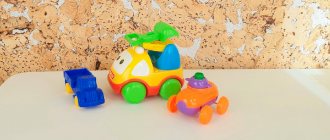With the birth of a baby, a period of unforgettable events begins in the family.
One of these moments is when a child begins to make his first sounds: cooing, cooing.
But when the baby is a little delayed in pronouncing sounds, mom and dad begin to look for reasons and take some measures to make the baby speak.
Often, a child’s silence is due to various factors that have nothing to do with developmental delays.
At what months should a baby begin to make his first sounds: cooing, cooing? How to speed up the process of the appearance of cooing in a baby?
Varieties of humming
In pediatrics and speech therapy, it is customary to distinguish two types of humming:
- hooting (is the initial stage of hooting, when the baby begins to pronounce short monosyllabic structures);
- pipe (the second stage of development of humming, in which the ability to stretch several syllables in a cascade appears; develops by the 4th month of life).
There is no interethnic or international distinction in humming - children from any linguistic and ethnic background hum the same. Only at the final stage of development of this type of communication (closer to six months of life) can features characteristic of a particular people appear in pronunciation.
Buzzing is also typical for children who are hard of hearing or deaf.
Consciously or reflexively
Tracing the exact line between babbling and the first words can be difficult. But an attentive parent can do it. When a child pronounces sounds unconsciously, he constantly repeats his favorite ones. But when he says “dad” when he sees his father or “give” when pointing at a toy, this is already conscious speech.
It is impossible to predict exactly when the first words will appear. The process of developing speaking skills is influenced by a number of factors. One baby pronounces more than 10 words by the age of one year, another – 1-2. In infancy, it is important for the baby to understand someone else’s speech addressed to him. This will allow you to form a vocabulary.
It’s easy to check how many words a one-year-old child knows. All you have to do is ask him to bring a car or a teddy bear. If you fulfilled the request or looked at the toy, it means you understood everything.
When children start to roar
Often parents do not notice changes in the baby’s pronunciation, missing the moment when the child develops the ability to pronounce individual vowel sounds. Then their speech may seem bizarre and unusual, since the sounds have an extended structure.
Such changes are noticeable already in the second or third month of life. At this age, the first communication skills are formed, when the child tries to communicate through the pronunciation of syllables, as well as simple sound structures. Pronouncing whole words is not typical.
The period of cooing lasts from 2 to 4 months, after which the baby begins to babble and learn to pronounce individual syllables, even words. By the third or fourth month of life, the baby can walk constantly, even for several hours a day without breaks. You can read more in detail in our article - when a child begins to gurgle and coo.
The structure of the cooing changes over time - at first it can be solo fragmentary sounds, which later become smoother, melodic and continuous.
In addition to vowels, when a child gurgles, he can learn to say long consonants like “m”, “s”, as well as the letters “b”, “p”. This makes speech more varied.
The earlier the better
This is not just a beautiful aphorism. This is exactly the case. We apologize if this answer somewhat disturbed your peace of mind. After all, many are accustomed to believing that a child’s upbringing, including musical education, should begin much later. And up to three or four he grows healthy, and thank God. The latest psychological and pedagogical research has shown that the time lost for education in preschool age is difficult to make up. The loss of the first years has especially irreversible consequences. From birth to 4.
A well-known supporter of the early active development of children, Masare Ibuka (Japan), who defends precisely this point of view, in his book “After Three It’s Too Late,” provides as evidence examples of children (several similar cases are known in India only) who were abducted by wolves in infancy , and at three or four years old they were found and returned to human life. Despite all the attempts of scientists (the story of Tarzan is a wonderful fairy tale), these children were unable to rise from the animal level of development. They could not learn not only to read or count, but even to speak clearly...
This, however, does not mean that we completely agree with the maximalism of Masare Ibuka or his modern Russian follower Pavel Tyulenev, who also claims that “after three it’s too late.” We think that everything is not so dramatic. There are many examples where children, whose early musical education no one was involved in, subsequently became not only great music lovers, but also professional musicians. Including high-level musicians. By the way, the question of the relationship between genetic predisposition and environment is interpreted differently and still remains open.
And yet, much speaks in favor of the fact that the early period in a child’s life is extremely important, that children under three or four years old have enormous life potential. Their consciousness is a blank slate. It has no stereotypical ideas and actively absorbs everything new. Gets to know the world around you. It is at this time that brain cells develop intensively. Children under 4 years old are ready to learn, want to learn, and enjoy learning. There is no doubt that this age-related phenomenon must be used.
Masare Ibuka talks about an experiment he led in early development Japan. One group of children aged 1-2 years was given constant, but small portions, listening to classical music (the choice fell on Beethoven's music by chance), while others were not allowed to listen. The children in the “Beethoven” group turned out to be more understanding and emotionally receptive.
What happens? What older children, like adults, learn over the years, slowly and difficultly, tiny toddlers master easily and playfully. A striking example is the study of foreign languages. In the seventies, the authors had an African American acquaintance in Moscow. His five-year-old daughter spoke four languages fluently - Russian, English, French and Spanish, although she did not specifically study any of the languages. It’s just that her dad spoke to her in English, her mother in Russian, her grandmother who lived with them in French, and, what is especially surprising, another grandmother in Spanish. It was surprising because this Spanish-speaking grandmother only visited her granddaughter twice a week for a few hours. The above fully applies to musical education.
How parents can help with boozing
Humming and babbling can be seen as ways of finding new ways to communicate. Parents should take this into account and support the baby by talking to him. This can be done like this:
- always respond to the sounds that the baby makes, encourage him;
- treat speech kindly - smile, show that the child is doing everything right, that his actions are pleasant to the parents;
- actively articulate when communicating;
- use gestural techniques to make speech more expressive; Sometimes you can also make a face to maintain interest;
- communicate actively and clearly.
It is also necessary to ensure that the process of speech development occurs in a calm environment, when there are no unpleasant or distracting factors.
Usually, a baby does not begin to coo in order to inform the parent about his needs or desires. Walking is perceived as a game, so in order for speech learning to be effective, you need to create favorable conditions for this - the baby must be clean, healthy and well-fed.
Music and movement
Music and emotions are closely related. Already at three or four months, the baby not only listens to music, but also perceives it emotionally. At the sound of a lullaby, he lies quietly and calmly. To the lively, cheerful music he smiles and rejoices. Cheerful music encourages the little ones to engage in a variety of activities: shouting, singing along, and dancing movements. Such activity must be supported in every possible way. You will give great pleasure to a tiny child who does not yet know how to sit if you take him by the hands and make various movements to the accompaniment of cheerful music. All this not only helps to improve his mood, develops motor activity, but also creates an important emotional connection: music is joy and pleasure.
With great interest, a child up to one year old listens to music to which adults move rhythmically with a flag or tambourine. A doll can successfully replace an adult. The doll marches to the march and makes dance moves to the waltz. The toy bird “sings” to the song. And “flies away” as soon as the music stops.
This is how music gradually enters the child’s life. He is already quiet and looks carefully at the source of the sound that his parents are about to turn on. He's waiting for the music.
What can you do if there is no partying?
There is no need to worry if the baby has not started to walk by the age of 2 months - with normal development, the process of learning the structure of speech is individual, so for some it can happen very quickly, while for others it happens late. Temperament matters - some children start playing very early, while others remain silent for no apparent reason.
You should consult a specialist if your child cannot walk at all by the age of 4 months. In such a situation, the pronunciation of fragmentary or smooth vowel sounds is completely absent. Then some developmental disorders are likely.
There is an opinion that walking can be taught through simple tasks and exercises, when silence is not caused by failures or deviations in intellectual and physical growth. Lack of cooing may be due to lack of communication. To begin with, the mother should talk to the baby more often, sing him calm children's songs and lullabies. When singing, it is advisable to draw out vowel sounds so that they can be heard and remembered.
It is necessary to create the right environment in the family - to ensure peace and well-being. Under no circumstances should you quarrel near a child, as this can ruin the child’s mood and affect the development of his communication skills. Learning sounds begins during play, and if the surrounding environment is unfavorable, the baby will not be able to do this. If relationships within the family improve, the child will quickly learn to walk.
Some doctors and parents recommend starting to develop fine motor skills as early as two or three months of age. Speech skills may depend on the degree of physical development, so you should pay attention to touching the baby’s hands and feet. You can also give him small objects to hold.
It is important not to yell at a child for misbehavior or force him to talk loudly, as this has the opposite effect - due to fear of parents, speech skills do not develop.
It is necessary to pay attention to the intonation of communication and correct it, since by the third month children are able to distinguish shades of mood and grasp the tone of the conversation. If the baby's babbling has begun, it will smoothly move into the babbling stage, in which syllables and simple words are formed.
Causes of speech delay and impairment in preschool age
If a child was born healthy, a delay in his speech development may occur due to incorrect actions of adults during the preparatory period: with insufficient verbal communication with the baby, inattention to his auditory perception, imitation of sounds and words of an adult, with untimely development of intonational expressiveness of speech and semantic connections between word and object.
Before speaking, the baby must train the muscles of the speech apparatus. This happens when he walks, babbles, breathes, swallows, sucks, chews. It has been noticed that children who were breastfed encounter speech difficulties less often than children who are fed artificially, and those who were promptly introduced to solid food speak much more clearly than their peers who were stuffed with liquid porridge and pureed vegetables almost before school.
Speech disturbances are caused by various reasons: congenital anomalies of the central nervous system, cerebral cortex, palate, tongue, defects in nasal breathing and decreased muscle tone of the soft palate (this pathology leads to nasality), mental trauma (for example, in impressionable children prone to neurosis a fear reaction can provoke stuttering), etc.
A child who was born deaf or who has lost hearing as a result of an illness in the first weeks and months of life will not learn to speak until a teacher of the deaf (a specialist who teaches speech to deaf children) teaches him to “lip read”, teaches him to pronounce individual sounds, and then words with relying on tactile, kinesthetic, and visual perception. Such activities should begin at the age of three or four.
The development of speech and thinking is closely related to the development of fine motor skills and coordination of finger movements. Children who work with construction sets, engage in origami, plasticine modeling, embroidery and other types of handicrafts, as a rule, are able to reason logically. Their memory and attention are quite developed.
Often, retraining a left-handed child to do everything with his right hand leads to delayed speech development and speech disorders. Modern mothers know that babies should not be swaddled. Any restriction of the baby’s movements inhibits not only the formation of motor skills, but also the timely development of speech functions. In a right-handed person, the actions of all moving parts of the body and especially the fingers, speech, articulation apparatus (larynx, pharynx, tongue, lips, soft palate) are genetically inherent in the left hemisphere of the brain, in a left-handed person - in the right hemisphere. If a left-handed person is not allowed to actively work with his left hand, then he will experience a spatial disruption in the formation of movements: the movements of the right, non-dominant hand will be stimulated, but the main, leading hand will remain without stimulation. By retraining the baby to hold a spoon or pencil in his right hand, parents thereby shift the innate functions of his leading right hemisphere to the left, in which he does not have a “projective” base for fine movements of the fingers and articulatory apparatus. As a result, speech developing on the basis of auditory perception “does not know” in which hemisphere it will “settle.” That is why often left-handers, who from infancy were diligently forced to do everything with their right hand, later begin to speak, pronounce many sounds incorrectly, are awkward in movements, do not know how to dance, and are deprived of an ear for music. But it is no less important that the emotional-volitional sphere of the child is disrupted. It is known that every action causes a reaction. The child becomes either stubborn or broken: weak-willed, suspicious, unsure of himself. He begins to pay attention to his speech difficulties and worries deeply about trifles. For this reason, he may develop a stutter. And it is difficult to overcome. A left-handed child needs to be given freedom of action, and he himself will learn to do a lot with both hands.
How can you develop your walking skills?
If your baby's humming is not too pronounced, you can try to speed up the development of the skill. To do this you should:
- talk to the baby not too loudly so as not to frighten him, and not too quietly so that what is said can be clearly heard;
- maintain a friendly tone of communication;
- do not weaken contact with the child at the visual level - it is important that the position of the adult’s lips and the manner of pronouncing the sound are visible (in some cases, children deliberately try to see this);
- maintain silence in the room, as extraneous noise can stop the noise and make you fall silent;
- play simple games like “ladki”;
- copy the child's manner of pronunciation - cooing and cooing in response, since the imitation reflex does not fade away at the age of six months (sometimes this is a method of therapy - children are played a hum recorded on a voice recorder to show them the correct model of speech development);
- gently massage the child’s cheeks, lips, belly and chest, while you can recite a children’s poem or sing a song - this helps develop children’s vocal delivery (it occurs suddenly);
- Praise the baby for his success in communication, support his activity.
You cannot distort words and lisp with children - incorrect pronunciation by parents causes incorrect reproduction of sounds when humming, and in the future - syllables and words.
Call for communication
The ability to use different signals to attract parents' attention to their activities or to meet their own needs is one of the most significant communication skills between the ages of 4 and 6 months. From Martha's diary: “When Matthew wants to be held and fed, his first signal is to squirm. Then he begins to make special sounds (“a-a-a-a-a”), interspersed with short sighs and exhalations, and turns to my chest. One day Matthew was fussy in my arms, and I couldn’t calm him down. He looked towards his child's chair and reached for it. When I figured out what he wanted and put that swivel chair at his disposal, peace was restored.”
What to do if your child stops walking
The sudden cessation of humming, if it has not turned into babbling, should cause concern among parents. It is better to show the baby to a specialist in such a situation to exclude the possibility of developmental deviations. This is especially true if the baby not only stopped walking, but also became lethargic and restless.
Parents can help on their own by continuing to talk to the child (expressively, emotionally, actively), copying the sounds of humming and hooting even if the baby no longer voluntarily pronounces them. You must always maintain a favorable psychological environment around the baby. This helps if the condition is not caused by intellectual or physical impairments.
Every parent of a baby should know what humming is, since this is an important process in the development of children's speech, during which the process of learning the correct pronunciation of individual vowels and sometimes consonant sounds occurs. Appears at the age of 2-3 months. You should consult a specialist if the child is lethargic, sad, has suddenly stopped humming, or was initially absent by the age of 7 months. But if the baby is cheerful, cheerful, and also active, it is most likely that the humming has not yet begun due to individual developmental characteristics.
The experience of the Alferov family
An interesting example of early listening to music, described in pedagogical literature, is the experience of the Alferov family. Both dad and mom loved music, but had no musical education. Grisha was allowed to listen to Bach's music (the choice of composer was random) starting from one month. The boy liked to listen: he turned his head to the sound of music and smiled. From the age of four months, the baby's selective ability became evident. He developed his own favorite works—violin concertos by Bach and Vivaldi. It is curious that Grisha did not like all Vivaldi concertos, but only some. The parents went into another room, went about their business and learned about the end of the music by the baby’s cry.
The experience of the Alferov family is extremely successful. At nine months old, Grisha listened to songs with pleasure and tried to hum. At the age of one, he was already singing several simple children's songs clearly. By the age of four, Grisha’s song repertoire is significant. It contains both children's and adult songs. He also likes to listen to classical music. Among his favorite composers are Bach, Vivaldi, Mussorgsky, Haydn. We don't consider Grisha a child prodigy. Because we know many examples when properly organized early listening to music, supported by the interest of parents, contributed to the active development of musical hearing, memory, and emotional sensitivity.
So, we have decided what kind of music to let the baby listen to and we are getting closer and closer to the next question.








